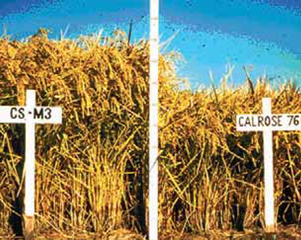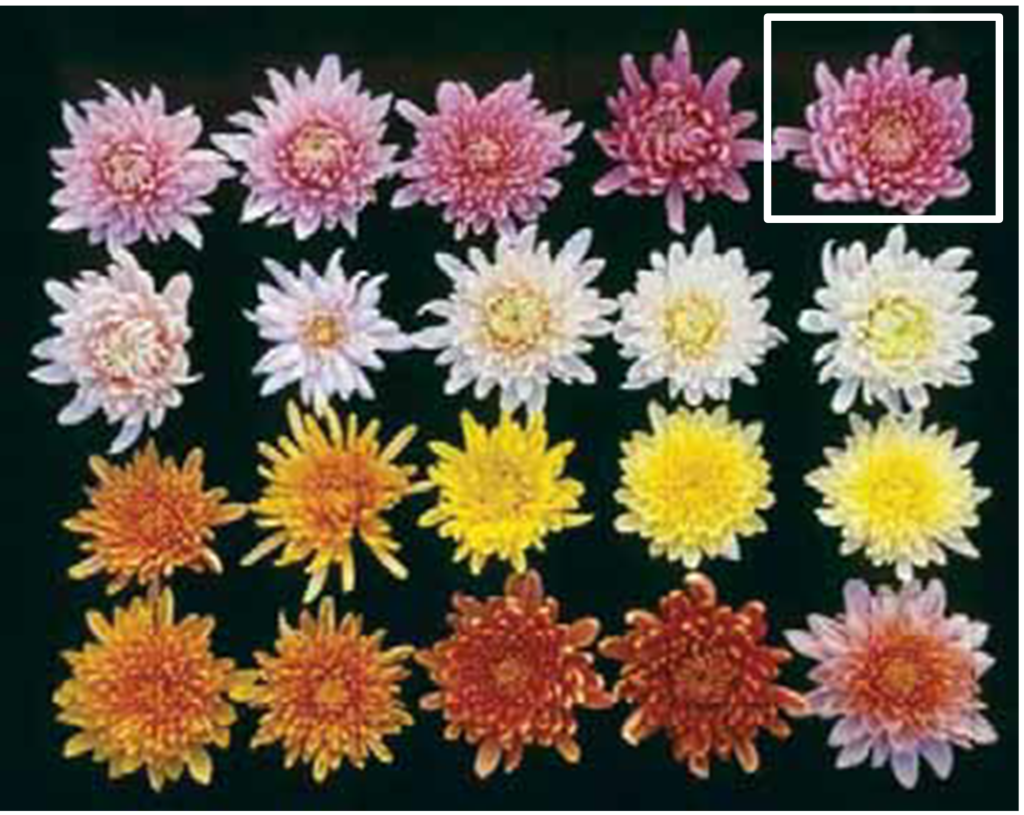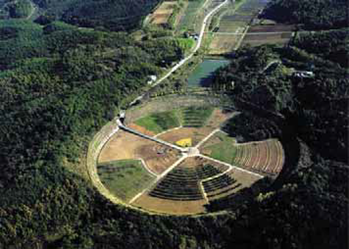Mutation Breeding
Walter R. Fehr and Walter P. Suza
Readings:
- Chapter 20: Mutation Breeding [pdf], Principles of Cultivar Development. Vol. 1: Theory and Technique, by Walter R. Fehr (Access the full book)
Introduction
Over the centuries, genetic improvement of plants has been achieved by utilization of the genetic variability from naturally occurring mutations. Although naturally occurring mutations can still be a valuable source of novel genes, there are instances in which none of the available germplasm of a plant species has a trait needed by a breeder. For example, soybean breeders were interested in modifying soybean oil to improve its shelf-life. None of the cultivars or the thousands of plant introductions had the necessary trait. Through the use of mutagenesis, genes were developed that made it possible to develop cultivars with the improved oil characteristics.
The text provides basic information on the factors that a breeder must consider in designing and conducting a mutagenesis program. The following discussion is intended to provide examples of how these principles were applied in creating novel genes. The text provided in the shaded boxes has been provided to clarify and expand on general principles of mutagenesis and is not part of the text of those articles.
Example 1
The information provided below for the development the rice cultivar Calrose 76 was obtained from Crop Sci. 16:631-635 (1976), Crop Sci. 17:978 (1977) and Induced Plant Mutations in the Genomics Era:44-47 (2009).
Step 1.
The cultivar Calrose was selected for irradiation.
The advantage of using an elite cultivar for mutagenesis is that it may be possible to identify a mutant that is suitable for release as a new cultivar without additional breeding, as was the case for Calrose 76. However, a plant with the desired mutation may not be suitable for release as a cultivar because it may contain undesirable mutations for other traits of importance. In those cases, the mutant allele is incorporated into elite germplasm by hybridization and selection.
Step 2.
There were 2,050 seeds of Calrose treated with each of five dosages of the physical mutagen cobalt-60: 0, 15, 20, and 25 kR.
The use of five dosages increased the chance of finding one dosage that would result in an adequate mutation frequency. The use of a control treatment made it possible to assess how each of the dosages influenced germination and the frequency of mutation.
Step 3.
Before treatment, the seeds were brought to 14% moisture.
Adjustment of moisture would be considered a pretreatment. It is assumed that the breeder had some prior knowledge that this step would be useful when using cobalt-60 radiation.
Step 4.
The M1 seeds were planted in the field. Although rice is self-pollinated, the M1 plants were isolated by 11 m from untreated rice genotypes to prevent outcrossing.
If a M1 plant had a recessive mutation, its M2 progeny would be expected to segregate in a 1:2:1 ratio. If outcrossing occurred and gametes with the wild-type allele from the untreated genotypes were responsible for fertilization, instead of those from the M1 plant itself, the frequency of homozygous mutant M2 progeny from a heterozygous M1 plant with a recessive mutation would be reduced to less than the expected ¼ frequency. This would make it more difficult to find M2 individuals with the desired mutation.
Step 5.
There were 200 individual plants harvested from each treatment and approximately 1,400 plants were harvested in bulk.
By harvesting individual plants, the breeder could have grown progeny from each. If an M1 plant was heterozygous for a mutant allele, recovery of a homozygous mutant M2 plant in the M1:2 line would be expected if a sufficient number of progeny were grown. To be 95% sure that at least one M2 plant from a heterozygous M1 plant would be homozygous for the mutation, 11 individuals would have to be evaluated in each M1:2 line. See page 367 of chapter 28 for an explanation of how this calculation was made. For 200 M1 plants and 11 progeny from each, a total of 2,200 M2 individuals would have to be evaluated.
The breeder also used a second alternative for managing the population, which was to harvest about 1,400 M1 plants from each dosage in bulk. This made it possible to evaluate progeny from more M1 plants, but reduced the number of M2 progeny that could be evaluated from each. If 2,200 M2 progeny were evaluated from the bulk, an average of only two M2 progeny from each of the 1,400 M1 plants would be tested from each. This illustrates an important choice that the breeder must make in harvesting and testing M2 progeny from a mutagenized population ie. testing more progeny of fewer M1 plants or fewer progeny from more M1 plants.
Step 6.
At maturity, short statured M2 plants were harvested individually. Undesirable plants, including haploids, triploids, and many semi-steriles were discarded.
It is common to find abnormalities in plants from mutagenized seed, particularly when physical mutagens such as gamma radiation are used.
Step 7.
The progeny of M2 plants were grown as M2:3 lines to identify those that were homozygous for short stature. Eleven of the lines were selected for further evaluation.
Progeny testing is essential to confirm that an individual plant has a mutant allele and whether the allele is stable from one generation to the next.
Step 8.
The selected lines were evaluated for yield in subsequent generations. One of the experimental lines, D7, became the cultivar Calrose 76.
The breeder carried out another important step by conducting a genetic study to determine the inheritance of the short statured trait in Calrose 76. This information was important for using the allele effectively in a rice breeding program. Short stature in Calrose 76 was found to be controlled by a single recessive allele that was designated sd1.
Example 2
Information found in Plant Breeding 129:412-416 (2010) describes the treatment of vegetative tissue of St. Augustinegrass by gamma irradiation to induce semi-dwarf mutants to be used as breeding material for cultivar improvement.
Step 1.
The clonal cultivar Raleigh was selected for irradiation. Raleigh had superior cold tolerance and was widely used as a home lawn in the southern U.S.
Step 2.
About 140 single node cuttings of uniform size from randomly sampled stolons were treated with cobalt-60. Irradiation treatment was conducted at a facility in the Nuclear Engineering Department at North Carolina State University. Dosages of 0, 50, 60, 70, 80, 90 and 100 Gy were used (1 Gy = 0.1 kR). For each dosage, 20 cuttings were treated. The single node cuttings used as the control were maintained in moist conditions to minimize dehydration. Dosage effect on callus tissue also was determined with 0, 25, 50, 100, and 200 Gy.
The importance of treating cuttings of uniform size was to ensure that radiation penetration was uniform for all materials treated. The inclusion of calli in this research was to test if the tissue is amenable to gamma irradiation. It was unknown whether calli could be used as starting material for mutagenesis in grass species.
Step 3.
The doses 50 to 70 Gy gave reasonably high survival rate for the cuttings. Based on this information, an additional 250 cuttings were treated for each of the 50 or 70 Gy dosages. The success of recovering plants from radiation-treated callus was higher for doses 25 and 50 Gy.
Step 4.
Plants obtained from radiation-treated node cuttings or calli were screened for freezing tolerance. Those that survived the cold treatment were screened for morphological changes.
It was important to screen for cold tolerance because any useful morphological mutants would need to be acceptable for the trait.
Step 5.
A total of 13 semi-dwarf mutants with tolerance to cold were obtained.
Example 3
An example of using chemical mutagenesis to develop herbicide tolerance in barley is described in [PNAS 108:8909-8913 (2011)].
Step 1.
The barley cultivar Bob was selected for mutagenesis with sodium azide to develop tolerance to imidazolinone herbicides.
Step 2.
Mutagenesis was done by treating about 500 grams of seed with 1mM sodium azide for 2 h.
Step 3. Before treatment, seed were pre-soaked at 0 oC for 16 h and subsequently at 20 oC for 8 h.
Step 4.
The M1 seed was planted in the field in isolation. The M2 seed was harvested in bulk.
Step 5.
About 2 million M2 plants were grown in a greenhouse where they were screened for resistance to the imidazolinone herbicide. The screening procedure involved placing 250 seeds in a Petri dish and soaking them with a 1,120.3 µM solution of imazethapyr for 48 h. The imazethapyr-treated seeds were subsequently planted in a commercial potting mix in flats that held 1000 seedlings. The seedlings were grown in a greenhouse under 16 h of light (22 oC) and 8 h of dark (16 oC). After four weeks in the greenhouse, seedlings were visually inspected for tolerance to the herbicide. Herbicide tolerant seedlings were transferred to pots and maintained under the same greenhouse conditions.
Step 6.
M2 plants showing tolerance to the herbicide were allowed to self-pollinate and each plant was harvested individually. About 5 to10 M3 progeny were grown from each M2 plant for seed increase. The M4 seed from each M2:3 line was harvested and each M2:4 line was evaluate for tolerance to the herbicide. Out of the 2 million M2 seedlings initially screened, only one line was found to be homogeneous for herbicide tolerance.
Step 7.
Herbicide tolerance was associated with a slight delay in seed germination. Thus, the new mutant line was backcrossed to Bob.
It is common that mutant lines have undesirable traits that preclude their use directly as a cultivar. The breeder must attempt to eliminate the negative traits by conventional hybridization and selection.
| Crop | Mutant Gerplasm | Mutation Method | New Trait | Reference |
| Rice | Calrose 76 | Gamma rays | Short stature | Crop Sci. 17: 978 (1977) |
| Wheat | FS4 | Sodium azide | Herbicide tolerance | Plant Physiol. 100: 882-886 (1992) |
| Soybean | A29 | Ethyl methanesulfonate | Reduced linolenate | US Patent No. 6 133 509. October 17, 2000 |
| C1726 | Ethyl methanesulfonate | Reduced palmitate | Crop Sci. 30: 240 (1990) | |
| A22 | N-nitroso-N-methylurea | Reduced palmitate | Crop Sci. 31: 88-89 (1991) | |
| Oats | Alamo-X | X-rays | Disease resistance | Crop Sci. 2: 531 (1962) |
| Bermudagrass | TifEagle | Gamma rays | Better turf quality when mowed | Crop Sci. 39: 1258 (1999) |
| TifWay II | Gamma rays | Nematode and cold tolerance, faster growth | Crop Sci. 25: 364 (1985) | |
| St. Augustine grass | TXSA 8202 | Gamma rays | Disease resistance | Crop Sci. 25: 371 (1985) |
| TXSA 8218 | Gamma rays | Disease resistance | Crop Sci. 25: 371 (1985) |



Review questions
You are a maize breeder who has the responsibility to develop an inbred line that has 80% oleic acid in the oil. Your first step was to evaluate the oleic acid content of the elite inbreds used in hybrids and inbreds available in the National Plant Germplasm System. The range in oleic acid among those inbred lines was from 16 to 48%. Consequently, you have decided to use mutagenesis in an attempt to develop a mutant allele that would increase oleic acid to 80%.
Design a mutagenesis program that could be used in an attempt to meet your objective. Provide specific information for each of the following and the rationale for your choice.
- Name of the mutagen you would use for the program and the reason for your choice.
- What characteristics would you consider in selecting the parent inbreds for treatment?
- How many inbred lines would you use if you can treat at total of 20,000 M0 seeds?
- Outline the steps in your treatment procedure beginning with the M0 seeds and ending when you have the M1 seeds ready to plant. Be sure to include any pre-treatment steps.
- How would you manage the M1 plants in terms of pollination and harvest?
- You can evaluate 40,000 samples for oleic acid content by gas chromatography. A sample can be an individual seed from a plant, but you must destroy the seed in the process. Alternatively, you can use as a sample a bulk of five seeds from a plant. Describe how you would evaluate the M2 seeds you harvested in the preceding question e.
- What would you grow in the M3 generation and how would you manage the pollination and harvest?
- How would you confirm that an individual with 80% oleic acid is homozygous and homogeneous for a mutant allele?

